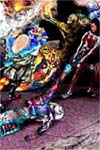 detail
from the "Malliarium"
detail
from the "Malliarium"
Detail
from the collaborative digital work by Stevesantos, Rosscapili, Jose Tence
Ruiz, Archie Degamo, George Cabig, Heber Bartolome, Nelson Viterbo and
Art Suarez.
|
Dubbed
Malliarium,
the collaborative work will span more than 7 meters across the CCP’s Little
Theater Lobby. As of production time, the mural’s “digital plate” has taken
over one gigabyte of hard disk space to process on a Mac G4 and Pentium
3, with 17 artists working together across varying platforms mostly through
networks.

eArt members plan
out the Malliarium at the CCP Little Theater Lobby (L-R) Mario Parial,
Rosscapili, Heber Bartolome, (top) Nelson Viterbo, Ige Ramos, Fatima Lasay,
Benjie Cabangis, (bottom) Ronnie Millevo, Jose Tence Ruiz, George Cabig
and Art Suarez.
eArt Philippines
progenitor Rosscapili regards highly the learning experience brought
about by the ambitious collaborative work to both viewers and artists,
pushing hardware and software (as well as temperaments) to their limits.
Working cross-platform on huge file sizes was a first time for many of
the artists and Rosscapili suggests a group workshop would enable everyone
to share experiences and processes. “It’s amusing,” he says, “just to finish
the work, some of the members had to bring in their entire CPUs. It’s an
experience I want all of us to know and learn.” “My new CD-writer had better
arrive soon,” quips Heber Bartolome, who also considers the collaborative
work an important creative experience, “ parang jamming sa musika.”
Al
Manrique also recognizes the value of collaboration, explaining “the
leadership (Ross), the shared vision, the trust, plus the technical
and artistic
capabilities of the members is
an experience
rare in the digital realm –
which is mostly
individualistic and detached
even when networked.”
If only Luna
were alive today ….
Why Luna’s Spoliarium?
An idea by Jose
Tence Ruiz from a 1997
project that
“went into my mental zip disk for
future consideration,”
he explains the
Spoliarium seemed
like a strong motif to
work on. “It
also has enough pop value for a
larger number
of Pinoys to reference as
opposed to some
more obscure work,” he
adds, “and this
was important if the reconfiguration was to be discussed, considered, debated,
noticed, even thoroughly
criticized.”

Assigning parts
of the Luna masterpiece to members of the group (L-R) Jose Tence Ruiz,
Fatima Lasay, Al Manrique and Ige Ramos.
|
On
the eArt discussion board, issues surrounding the choice of subject continue
to be debated, sparked by Art Suarez’s flood of questions and criticism.
Spoof, satire,
appropriation?
“The term is
repurposed,” says Al Manrique, “We only used Luna’s figurative and com-positional
elements. The figures were repurposed according to each artist’s temperament.
What came out is a marketplace of styles much like a mall.” Although there
have been prior efforts of other artists’ groups at repurposing the Spoliarium,
the scale of the Malliarium may be enough to elicit critical attention.
“The artistic
license in dealing with repurposing materials aims to give an old message
a current relevance is another realm which the old individualist and gallery-based
school may not get and may react violently to,” explains Al Manrique.
Rosscapili agrees
and sees the entire work as a depiction of mall culture, but looks forward
to doing collaborative work again this time with an original piece coming
from each artist.
For George
Cabig, the collaborative work served as a means of showing the transformation
of media from Luna’s time to the age of digital technology.
Digital Compositing
In assessing
the assembled Malliarium, Fatima Lasay takes on Luna’s masterful
com-position and suggested digital adjustments in gamma, saturation and
contrast to bal-ance the work where almost every element was glaring for
attention.
“I like the
darkly mood of the original Spoliarium where you have to search the work
to make out the figures and understand it,” she says, “things were not
readily apparent and obvious or glaring which gives the work the essence
of timelessness – work that does not end with one look.” Thanks to digital
compositing, elements in the entire composition can be independently
adjusted without
having to “recompile” the entire image which would be a timeconsuming
process.
Building the
Malliarium started with parts of the Luna masterpiece distributed among
members of the
group. Benjie Nuval and Rosscapili then headed the digital assembly
of the final work with further fine tuning inputs from the members through
viewing on the web and internet email.
“The final piece
is a surprise,” says Al Manrique, Dopy Doplon muses, “I really didn’t
have any inkling as to what the guy next to my piece would be rendering,”
and he adds, “I was surprised because we didn’t think we would build the
mural in cohesiveness and harmony; you doing your piece in the comfort
of your workplace, and me in between office breaks. This demonstrates the
access of creativity through technology.” For the show’s opening day, a
plotter will be placed in the exhibition hall for printing the final tile
to complete the mural. During the show, eArt Philippines will sell 11”
x 17” edition prints of the Malliarium signed by all participating artists.
Malliarium is
set to open September 19, 2000 at the CCP’s Little Theate Lobby Other participating
artists include Archie Degamo, Benjie Cabangis, Stevesantos,
Mario
Parial, Ronnie Millevo, Ige Ramos and Nelson Viterbo. |

